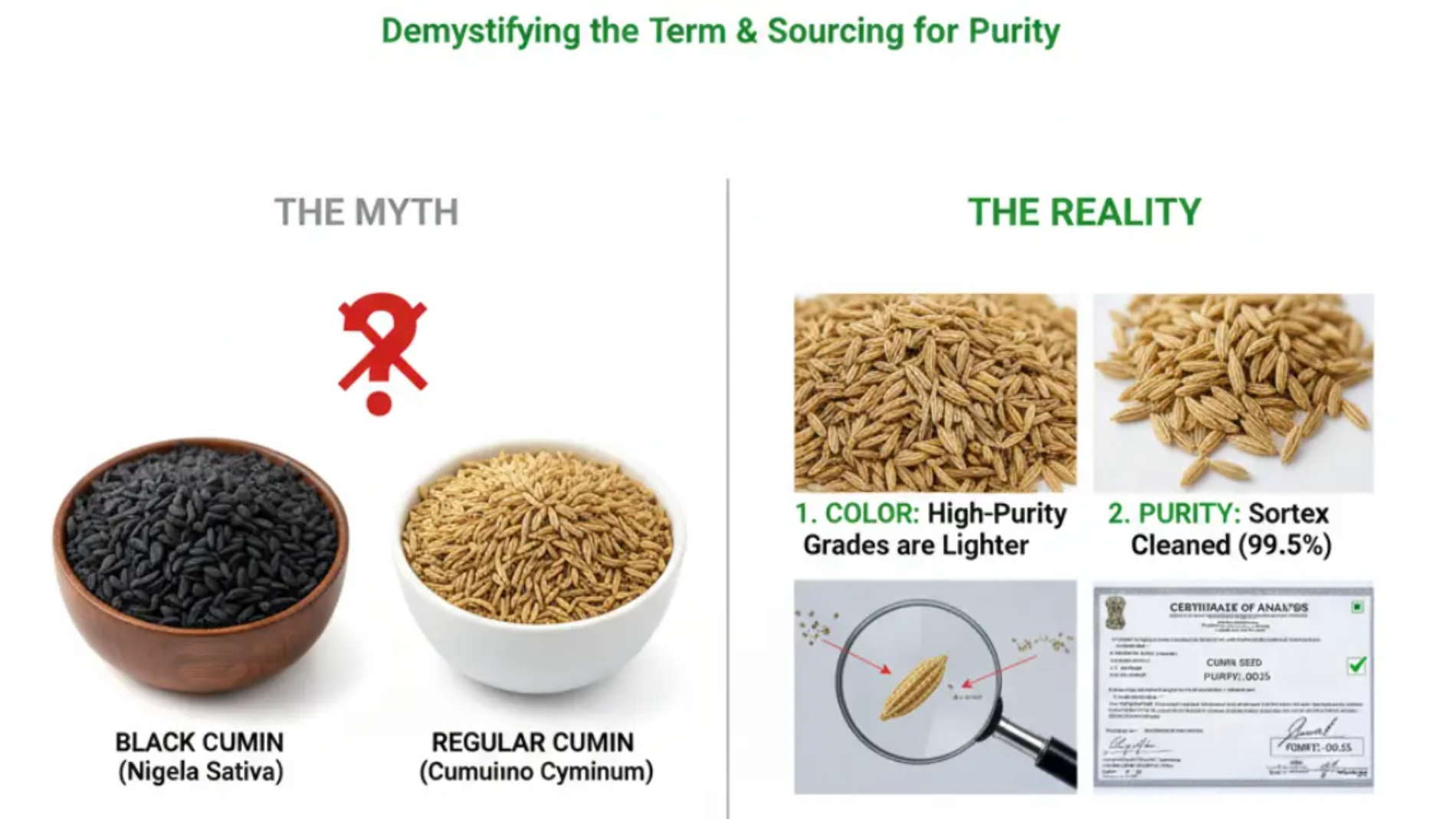In the world of international spice sourcing, precision is everything. The difference between profit and loss can often come down to the exact specification of an ingredient. Yet, some terms used in the trade are ambiguous and can lead to confusion and costly mistakes. One of the most common points of confusion for cumin importers is the request for “White Cumin Seeds.”
While buyers may have a specific quality in mind when using this term, it’s a name that can be misleading. As an experienced exporter based in Pune, at the heart of the Indian spice market, we believe in clarity. This guide will demystify the term “white cumin,” explain what it really means in the commercial trade, and provide a clear roadmap for sourcing the high-quality Indian cumin seed you’re actually looking for.
Demystifying the Term: What Are "White Cumin Seeds"?
Let’s start with the most important fact: “White Cumin Seed” is not a distinct botanical variety. Unlike the clear difference between regular cumin and Black Cumin (Nigella Sativa), there is no commercially grown plant that produces truly white cumin seeds.
The term “white cumin” has emerged in the trade to describe two things:
A Differentiator from Black Cumin: It’s often used simply to refer to standard cumin (Curcumin sativa), or jeera, to distinguish it from the completely unrelated “Black Cumin” (Kalonji).
A Descriptor for High Quality: More importantly, it is used to describe a premium grade of regular cumin seed that, due to superior processing, has a lighter, more uniform brownish-yellow, or “whiter,” appearance.
In essence, a lighter colour is a result of high-quality processing, not a different type of plant.
Spice Up Your Business with Authentic Indian Flavors
Import and Export Excellence from India!

From "White" to "Right": Focusing on Purity Grades
Instead of using the ambiguous term “white,” experienced importers specify the quality they need using the industry-standard language of purity grades. This eliminates confusion and ensures you get a consistent product. The two main international grades for Indian cumin seed are:
Singapore Grade (99% Purity): This is the standard for many global markets, allowing for a maximum of 1% foreign matter.
Europe Grade (99.5% Purity): This is a premium grade with even stricter purity requirements, allowing for a maximum of only 0.5% foreign matter. This higher purity often results in a cleaner and visually lighter product.
The Role of Cleaning: Machine Cleaned vs. Sortex Cleaned
The appearance and purity of cumin are directly related to the cleaning method. This is often what separates a standard grade from a “whiter,” premium grade.
Machine Cleaned: This is a standard process that effectively removes most large impurities like dust, stalks, and stones.
Sortex Cleaned: This is an advanced, optical sorting process. High-resolution cameras scan every single seed, and puffs of air instantly remove any discoloured seeds, damaged seeds, or remaining foreign matter. It is the Sortex cleaning process that produces the most visually uniform, lightest-coloured, and highest-purity cumin grades.
An importer looking for “white cumin” is, in reality, looking for Sortex Cleaned, Europe Grade cumin.
The Importer's Sourcing Checklist
To avoid ambiguity and ensure you receive the exact quality you need, use this checklist when communicating with your cumin supplier:
Specify the Botanical Name: State that you require cuminum cyminum (Jeera).
Define the Purity Grade: Clearly request “99% Purity (Singapore Grade)” or “99.5% Purity (Europe Grade).”
State the Cleaning Method: For the highest quality and lightest appearance, specify “Sortex Cleaned.”
Request a Pre-Shipment Sample: A physical sample is the best way to visually verify that the colour, cleanliness, and aroma meet your standards.
Demand a Certificate of Analysis (COA): This is your final guarantee. The COA is a lab report for your specific batch that will provide documented proof of all key specifications, including purity and moisture content.
Spice Up Your Business with Authentic Indian Flavors
Import and Export Excellence from India!

Sourcing with Clarity and Confidence
The quest for “White Cumin Seeds“ is ultimately a quest for the highest quality and purity of regular Indian cumin seed. By replacing ambiguous colour descriptions with precise, technical language, importers can eliminate confusion, mitigate risk, and build a reliable and predictable supply chain.
Partnering with a knowledgeable supplier who understands these critical distinctions is the key to successful spice sourcing. When you source with clarity, you source with confidence.
Frequently Asked Questions (FAQs)
1. So, if I order “white cumin” from a supplier, what will I likely receive?
You will most likely receive a high-quality, Sortex-cleaned grade of regular brown/yellow cumin ( Cuminum cyminum). A good supplier will clarify your exact purity requirements rather than just shipping a product.
2. Is higher-grade “whiter” cumin more expensive?
Yes, Sortex Cleaned, Europe Grade (99.5% purity) cumin commands a premium price over standard, machine-cleaned grades due to the advanced processing and lower yield of only the best seeds.
3. What is the scientific name for true cumin?
The scientific name for the common cumin seed, or jeera, is Cuminum cyminum.
4. Why is cumin so often confused with black cumin?
The similar names are the primary cause of confusion. However, they are botanically unrelated, look different, and have completely different flavour profiles. Regular cumin is earthy and warm; black cumin (Kalonji) is pungent and peppery.
5. Does the colour of cumin affect its flavour?
While a lighter colour is primarily an indicator of purity and cleanliness, a batch with many dark, damaged seeds may have a slightly inferior or less fresh flavour. The main driver of flavour, however, is the volatile oil content.
6. What is the Unjha market, and why is it important?
The Unjha market in Gujarat, India, is the world’s largest trading hub for cumin. It is where global prices are largely determined and where the standards for different purity grades are set.
7. What is a good moisture content for cumin seeds for export?
For a long and stable shelf life, the moisture content for export-grade cumin should be low, typically between 7% and 9%. This should be verified on the COA.
8. Can I get a sample before placing a large import order?
Yes, any reputable cumin supplier will provide a pre-shipment sample for you to evaluate the quality, colour, and aroma before you commit to a bulk purchase.
About us
We bridge the gap between local producers and global markets, ensuring seamless trade facilitation with exceptional quality and reliability. We provide quick delivery services with customized packaging with all approval of International Certificates (Spices board India, MSME, IEC, fssai, FIEO, APEDA, EU certification, FDA and Many More)
Contact us
Shop No. 3, Ganesh Prestige Sr. No. 2/15, Near Laxmi Jewellers, Dhanakawadi, Pune – 411043, Maharashtra INDIA.
Call On
+91 9545205050
+91 9822422584



Leave A Comment